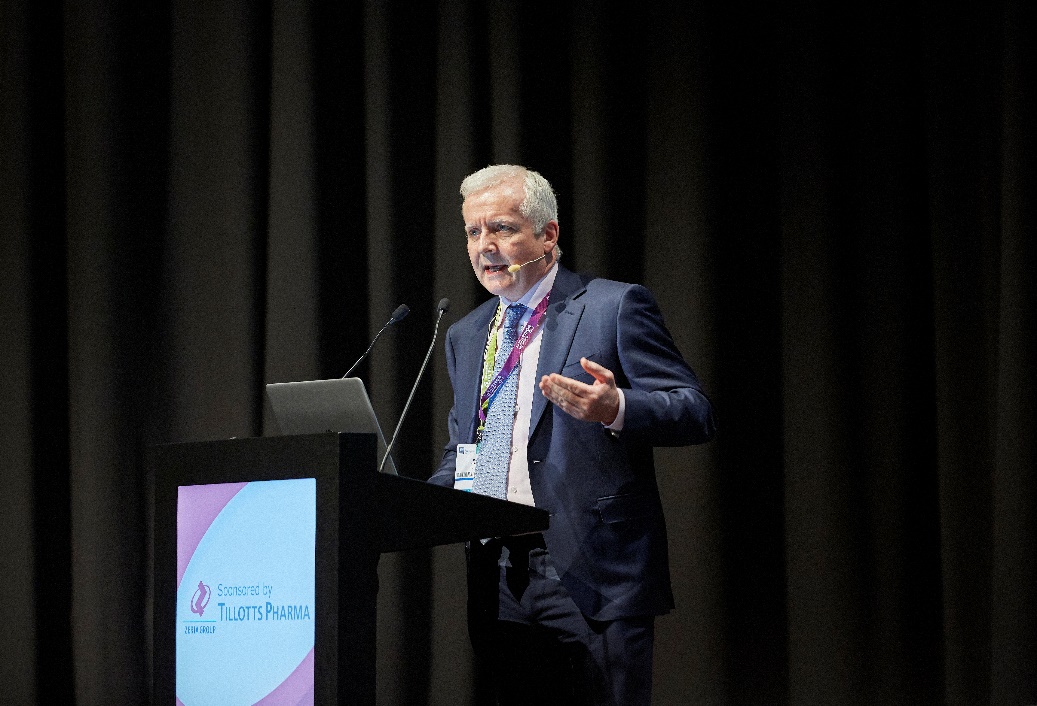SMART SIMPLICITY - Tillotts Symposium Report
Simplifying treatment options and processes
The satellite symposium sponsored by Tillotts Pharma was introduced by the Chair, Geert D’Haens, Amsterdam, the Netherlands.
Due to the nature of the disease, treatment of Inflammatory Bowel Disease (IBD) is complex. National and international guidelines are available to aid the decision making of the treating physician, but in clinical practice, differences exist between textbook and reality. Below we provide a summary of the presentations of the two speakers.
Disclaimer: The views and opinions expressed are those of the speakers and not necessarily of Tillotts Pharma. The satellite symposium is not affiliated with the European Crohn’s and Colitis Organisation (ECCO). The article was created by Tillotts Medical Affairs.
 Tillotts Symposium 2019 Tillotts Symposium 2019 |
Difference between textbook and reality in IBD
Real-life clinical practice in IBD often differs from treatment guideline recommendations; this was highlighted in a case presentation of a 44-year-old female diagnosed with Ulcerative Proctitis. Initially treated with 5-ASA suppositories (as per the ECCO Guidelines) with a suboptimal response, a second gastroenterologist switched the treatment to oral 5-ASA, where again complete remission was not observed. A recent sigmoidoscopy showed a disease extension of 25 cm. According to the ECCO Guidelines on the treatment of Ulcerative Colitis (UC), such a patient “should initially be treated with an aminosalicylate enema ≥1 g/day [EL1] combined with oral mesalamine ≥2.4 g/day [EL1], which is more effective than oral or topical aminosalicylates, or topical steroids alone [EL1]” [1]. With Evidence Level (EL) 1, this recommendation is based on high-quality randomised trials.
 Ala Sharara, Beirut, Lebanon Ala Sharara, Beirut, Lebanon |
All work packages have now started and made progress.
From a scientific standpoint, evidence-based medicine – including guidelines and consensus documents – provides useful tools for patient treatment. The extent to which these guidelines are referred to by gastroenterologists is often unknown. Adherence to the ECCO Guidelines on mild to moderate UC was assessed in a cross-sectional survey conducted in Spain. Agreement with the Guideline was high, although discrepancies were noted, including the fact that only 25% of general gastroenterologists use a combination of oral and topical 5-ASA for treating extensive UC compared with 45% of gastroenterologists specialised in IBD [2]. These results emphasise that there is a disconnect between the treatment guideline recommendations (e.g. the use of combination therapy in extensive UC) and clinical reality.
Treatment outcomes can be further complicated as patients with IBD often do not receive the optimal therapy. In a study population consisting of 67 consecutive patients [21 with UC, 44 with Crohn’s Disease (CD) and two in whom the diagnosis of IBD could not be confirmed], of the 33 patients treated with 5-ASAs, 21 (64%) were not receiving maximal doses. Most strikingly, nine out of 12 (75%) patients with distal UC were not receiving rectal 5-ASA therapy. The study highlights that IBD patients often do not receive optimal medical therapy [3]. As demonstrated above, there remains a gap between adherence to treatment guidelines and clinical practice. This is also shown in a retrospective data collection of patients attending a tertiary Australian hospital IBD clinic over a 12-month period. Management practices were audited and compared to the ECCO Guidelines. Overall, almost a third of physicians were not adhering to disease management guidelines, stressing the divide between guidelines and real life [4].
In addition to the gap between adherence to guidelines and clinical practice, there is a further issue regarding adherence to treatment in IBD, i.e. non-compliance of patients in taking their medication. The latter is a well-recognised concern amongst the IBD community. A prospective study by Kane et al. in 2003 investigated the effects of non-adherence. A cohort of 99 consecutive UC patients who were in remission for ≥6 months and were taking mesalazine were followed up. At 12 months, patients who were not adhering to the medication (defined as refilling less than 80% of the prescribed medication) had a more than fivefold greater risk of recurrence than adherent patients. Non-adherence to mesalazine was the single most important predictive factor for relapse [5].
Guidelines are an important source of information, but one must also rely on a combination of clinical judgement and knowledge of the disease. The ECCO Guidelines are based on expert opinion and varying levels of evidence according to the guidelines of the Oxford Centre for Evidence-Based Medicine (Oxford, UK), ranging from EL1 – large randomised controlled trials (RCTs) – to EL5 – based on expert opinion, no controls and case series only. As regards the level of evidence for ECCO Guidelines on the treatment of CD, just under half of the evidence comes from randomised trials, but on the other hand that equates to more than half being based on non-randomised, lower-quality evidence.
As already mentioned, the highest level of evidence (EL1) derives from RCTs. However, patients enrolled in RCTs do not in general represent the IBD patient population, with most moderate-severe patients in an outpatient practice not qualifying for enrolment in pivotal RCTs of biological reagents [6].
The differences between RCTs and real-world evidence are outlined below [7].
Randomised control trials:
• Patients are randomised to the treatment; physicians’ and patients’ choices are not considered for selection of the treatment.
• Non-adherent patients are removed from the analysis
• Experiment is based on an artificially created (homogeneous) group.
The purpose here is to establish the efficacy of the medication/therapy.
Real-world evidence:
• Therapy or medication is determined by physicians’ choices as per the standard practice and experience.
• Non-adherent patients can switch treatment and in such an event are likely to remain included.
• Relates to a heterogeneous patient population reflecting a realistic scenario.
The study is likely to indicate the effectiveness of the drug/therapy under various conditions.
Ala Sharara went on to state, that with a third of IBD patients in daily practice not meeting the criteria for entry into an RCT [6], there are many complex patients and the guidelines have difficulties in dealing with these populations. He concluded that the "real-life practice of IBD is challenging”. Clinical guidelines are useful, but fall short in highly complex diseases. A combination of evidence-based medicine narrows this gap and should drive future research. Lastly, personalised medicine is needed and is what one should strive for, but many questions remain.
Discussion:
Geert D’Haens went on to comment that in “real-world experience” publications, the success rates with drugs are often higher than those observed in clinical trials. Ali Sharara then mentioned that patients enrolled in clinical trials are often different to those in real life. This raises the question, Should clinical trial enrolment include more patients with more co-morbidities? Geert D’Haens argued that the goal of clinical trials is to show that the molecule works and that it is safe. One does not want safety signals in clinical trials that are not caused by the novel molecule, but by co-morbidities or concomitant medication. Indeed, safety remains a paramount factor. It was concluded that there is currently an unmet need in these more complex patients, and it is important to keep publishing real-world data/experiences.;
Confusing terminology in IBD
It is important in gastroenterology to use clear terminology. Using language that allows patients to understand their disease and their medication schedule and therefore to adhere to the treatment regimen is imperative.
 Hugh Mulcahy, Dublin, Ireland Hugh Mulcahy, Dublin, Ireland |
Guidelines in general are good, but sometimes they are complex, lengthy and too rigid for clinical practice. A Dutch observational study was performed to investigate which attributes of guidelines or specific recommendations for appropriate care are related to their use in practice and in clinical decision-making. The study demonstrated that evidence-based recommendations were used more than recommendations for practice that were not based on research evidence. The study concluded that if guidelines are clear, then they are more likely to be adhered to [8].
Clear and precise terminology allows medical professionals to understand each other and communicate effectively. Understanding the medical terminology enables all involved to understand staff communications and training. Ambiguity and vagueness in practice guidelines reduce the likelihood of clinician adherence and lead to inconsistent interpretation, practice variation and medical errors. Ambiguity exists when a term can reasonably be interpreted in more than one way, whilst vagueness occurs when the boundaries of a word’s meaning are not well defined (e.g. moderate, elderly, adequate). Vagueness reduces the clarity on whether or not the action should be performed [9].
Many ambiguous terms are being used in the field of IBD. The definition of moderate UC and mucosal healing are two good examples. With both these terms, no one clear definition exists. It is important to consider this when interpreting the guidelines.
In both clinical trials and clinical practice, endoscopic activity has become a therapeutic endpoint in IBD. Inter-observer agreement for endoscopic scores in a real-life setting in Italy were evaluated. Fourteen gastroenterologists with experience in IBD care and endoscopic scoring reviewed videos of UC (n=13) and postoperative (n=10) and luminal (n=8) CD. Mayo subscore agreement was suboptimal: kappa values were 0.53 (95%CI 0.47–0.56) and 0.71 (95%CI 0.67–0.76) for the two groups. The authors concluded that the reproducibility of endoscopic scores in IBD remains suboptimal, which could potentially have major effects on therapeutic choices [10].
Using precise and appropriate language when writing guidelines is difficult. The guidelines consist of complex and ambiguous statements, which are potentially confusing for someone whose first language is not English. Having a closer look at the ECCO Guidelines, there are many examples of the use of ambiguous language, such as “long-term”. The use of vague language, such as “mild or moderately active” and “acceptable” can also be found. Non-specific wording such as “some” and “almost all” also predominates.
In summary, clear guidelines are essential. It is necessary to have a balance between ambiguity and overly complex guidelines that try to answer every complex case.
Discussion:
After two interesting and informative talks, the discussion was opened to the audience. The following is a summary of the most interesting points that were raised.
National vs. international guidelines: In Europe, national guidelines sometimes differ from international guidelines. The NICE guidelines are a good example, as they are real-life guidelines which also take into account the NHS financing. It was agreed amongst the panel that due to economic reasons, complete standardisation of guidelines is not possible. It was suggested that perhaps the guidelines need to be expanded to take into account the payers. This highlights the importance of local guidelines and the fact that there are realities on the ground that influence treatment choices.
Roadmaps: Guidelines are known to be lengthy and, as confirmed by the audience, are not always read in full. The benefits of roadmaps were discussed; however, the more complex the disease, the more difficult it is to have a comprehensive road map that can manage the wide variety of issues that can arise during the treatment of an IBD patient. Interpretation of summary box recommendations can also be difficult. It was agreed that the current ECCO Guidelines are a good summary, but that there is potential danger when they are used by inexperienced physicians, highlighting the importance of education.
In conclusion, IBD is special due to its complexity. It is a challenge, and one needs to be humble and accept that not all treatments will be effective. Guidance is available to guide the treating physician. Alongside this, multidisciplinary teams and specialised centres play a pivotal role in patient care. There remain many unanswered questions, and building on the current knowledge and education will be the key to future success.
References
- Harbord M, Eliakim R, Bettenworth D, et al. Third European Evidence-based Consensus on Diagnosis and Management of Ulcerative Colitis. Part 2: Current Management. J Crohns Colitis. 2017;11:769–84.
- Gisbert JP, Gomollon F, Hinojosa J, Lopez San Roman A. Adherence of gastroenterologists to European Crohn's and Colitis Organisation consensus on ulcerative colitis: a real-life survey in Spain. J Crohns Colitis. 2010;4:567–74.
- Reddy SI, Friedman S, Telford JJ, Strate L, Ookubo R, Banks PA. Are patients with inflammatory bowel disease receiving optimal care? Am J Gastroenterol. 2005;100:1357–61.
- Jackson BD, Con D, Liew D, De Cruz P. Clinicians' adherence to international guidelines in the clinical care of adults with inflammatory bowel disease. Scand J Gastroenterol. 2017;52:536–42.
- Kane S, Huo D, Aikens J, Hanauer S. Medication nonadherence and the outcomes of patients with quiescent ulcerative colitis. Am J Med. 2003;114:39–43..
- Ha C, Ullman TA, Siegel CA, Kornbluth A. Patients enrolled in randomized controlled trials do not represent the inflammatory bowel disease patient population. Clin Gastroenterol Hepatol. 2012;10:1002–7.
- Cognizant 20-20 insights. Real-world evidence: A better life journey for pharmas, payers and patients. April 2015.
- Grol R, Dalhuijsen J, Thomas S, Veld C, Rutten G, Mokkink H. Attributes of clinical guidelines that influence use of guidelines in general practice: observational study. BMJ. 1998;317:858–61.
- Codish S, Shiffman RN. A model of ambiguity and vagueness in clinical practice guideline recommendations. AMIA Annu Symp Proc. 2005:146–50.
- Daperno M, Comberlato M, Bossa F, et al. Inter-observer agreement in endoscopic scoring systems: preliminary report of an ongoing study from the Italian Group for Inflammatory Bowel Disease (IG-IBD). Dig Liver Dis. 2014;46:969–73.


